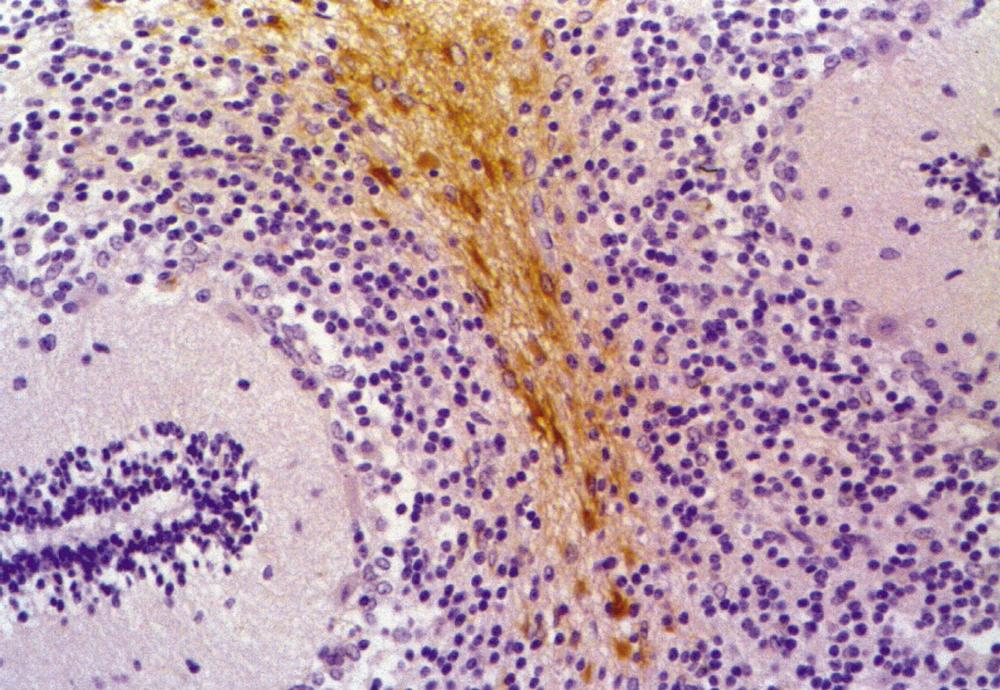GFAP Mouse Monoclonal Antibody [Clone ID: GF-01]
Other products for "GFAP"
Specifications
| Product Data | |
| Clone Name | GF-01 |
| Applications | IF, IHC, IP, WB |
| Recommended Dilution | Western Blotting. Immunoprecipitation. Immunocytochemistry: 5-10 µg/ml. Immunohistochemistry on Paraffin Sections: 10 µg/ml. The antibody strongly stains astrocytes in Human brain tissue sections but it is essentially negative on Mouse and Rat tissues. |
| Reactivities | Human, Porcine, Feline |
| Host | Mouse |
| Isotype | IgG2b |
| Clonality | Monoclonal |
| Immunogen | Pellet of Porcine brain cold-stable proteins after depolymerization of microtubules. |
| Specificity | The antibody reacts with GFAP molecules. GFAP is the principal marker of astroglial cells in the central nervous system; it is specifically expressed in satellite cells in peripheral ganglia and in non myelinating Schwann cells in peripheral nerves. The GFAP protein runs on gels at ~55 kDa protein, usually associated with lower Mw bands which are thought to be proteolytic fragments and alternate transcripts from the single gene. |
| Formulation | Phosphate buffered saline (PBS), pH~7.4 with 15 mM Sodium Azide as preservative State: Purified State: Liquid purified Ig fraction |
| Concentration | lot specific |
| Purification | Protein-A Affinity Chromatography |
| Conjugation | Unconjugated |
| Storage | Store the antibody undiluted at 2-8°C for up to one month or (in aliquots) at -20°C for longer. Avoid repeated freezing and thawing. Should this product contain a precipitate we recommend microcentrifugation before use. |
| Stability | Shelf life: one year from despatch. |
| Database Link | |
| Background | Glial Fibrillary Acidic Protein (GFAP) was discovered by Bignami et al. (1972) as a major fibrous protein of multiple sclerosis plaques. It was subsequently found to be a member of the 10 nm or intermediate filament protein family, specifically the intermediate filament protein family Class III, which also includes peripherin, desmin and vimentin. GFAP is heavily, and specifically, expressed in astrocytes and certain other astroglia in the central nervous system, in satellite cells in peripheral ganglia, and in non-myelinating Schwann cells in peripheral nerves. In addition, neural stem cells frequently strongly express GFAP. It is also found in the lens epithelium, Kupffer cells of the liver, in some cells in salivary tumors and has been reported in erythrocytes. Although its function is not fully understood, GFAP protein is probably involved in controlling the shape and movement of astrocytes. The protein probably also plays a significant role in the interactions of astrocytes with other cells, which are required for the formation and maintenance of the insulating layer (myelin) that covers nerve cells. Additionally, GFAP protein may assist in maintaining the protective barrier that allows only certain substances to pass between blood vessels and the brain (blood-brain barrier). In adults, GFAP levels increase as a result of the proliferation of astrocytes that occurs in a response to a variety of physical, chemical and etiological insults, including Alzheimers disease, epilepsy and multiple sclerosis. Antibodies to GFAP are therefore very useful as markers of astrocytic cells and neural stem cells and for distinguishing of neoplasms of astrocytic origin from other neoplasms in the central nervous system. Finally, Alexander's disease was recently shown to be caused by point mutations in protein coding region of the GFAP gene (Brenner et al., 2001). All forms of Alexander disease are characterized by the presence of Rosenthal fibers, which are GFAP containing cytoplasmic inclusions found in astrocytes. |
| Synonyms | Glial Fibrillary Acidic Protein |
| Reference Data | |
Documents
| Product Manuals |
| FAQs |
| SDS |
{0} Product Review(s)
0 Product Review(s)
Submit review
Be the first one to submit a review
Product Citations
*Delivery time may vary from web posted schedule. Occasional delays may occur due to unforeseen
complexities in the preparation of your product. International customers may expect an additional 1-2 weeks
in shipping.






























































































































































































































































 Germany
Germany
 Japan
Japan
 United Kingdom
United Kingdom
 China
China




